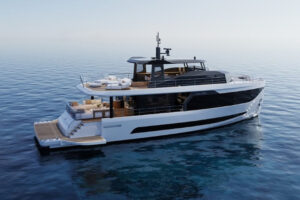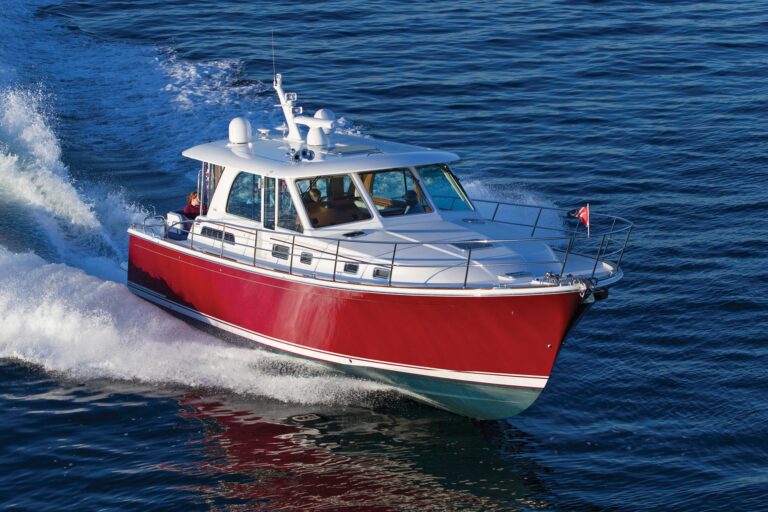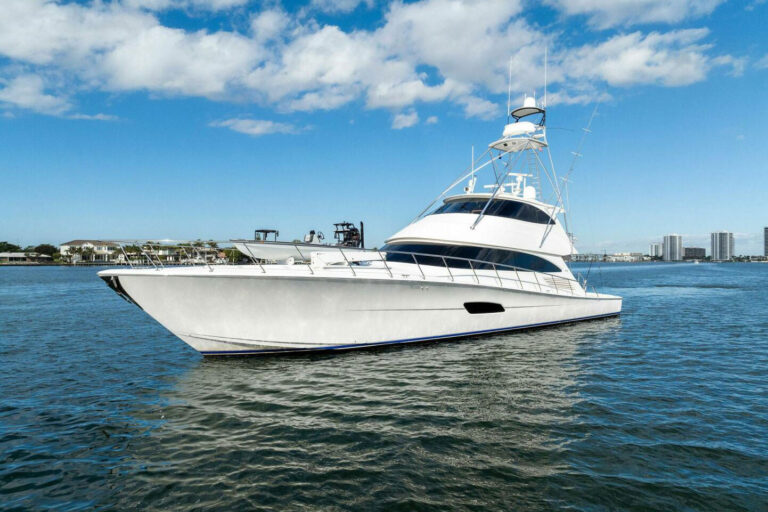
| |Photo courtesy of the Kennedy Library.|
Even for many born a generation or more after President John F. Kennedy’s death in 1963, the iconic images of the president on the fantail are as vivid as any memory of any president. But as I looked through the exposed skeleton of Honey Fitz — Kennedy renamed the presidential yacht with the nickname of his maternal grandfather, turn-of-the-century Boston Mayor John Francis Fitzgerald — I wasn’t seeing a thin slice of history. I was looking forward through time, beginning when the steel stringers were welded and oak frames steam-bent by men lucky to be working at the height of the Great Depression. Her preservation, at a cost of $3.5 million during 30 months in the shipyard, is as important to yachting history as it is to presidential history.
Originally called Lenore II and built for Montgomery Ward Chairman Sewell Avery, the boat was a big deal in her day. “She is a new type and for a new purpose and in her is presented a combination of speed and weatherliness,” wrote Reginald W. Crowly in Yachting‘s June 1932 issue. “She is the busy man’s yacht, able to lop off the miles in short order — a fast cruiser in which to go places in hours snatched at week-ends and on short vacations.”
Lenore II‘s speed, range and economy — “twenty-four miles per hour for 24 hours, at a cost of about $3.50 per hour,” the 1932 article states — were owed in part to the new 500-horsepower Winton diesels, but also to her unique composite construction.

Photo courtesy of the Historical Collections of the Great Lakes, Bowling Green University.
“The hull was built like a 90-foot canoe,” says Jim Moores, owner of Moores Marine, the company that recently restored the hull of Honey Fitz. “The size of the ribs was typical of a 30-footer.” Lenore II‘s naval architect Thomas Bowes specified Douglas fir planking, cut “vertical grain” so each plank would have better strength for its weight. Two layers of planks were fastened with copper rivets. It was the 1930s version of today’s laminated cold-molded construction.
Double planking wasn’t new, but Lenore II‘s steel keelson, stringers and bulkheads, all interconnected with steel frames, were considered state of the art. “This construction,” Crowly wrote, “forms a long, deep girder or bridge extending the full length of the yacht [providing] great rigidity and strength for a given weight at very low cost.”
As happened to many private yachts during World War II, the U.S. government commandeered Lenore II and assigned her to the Coast Guard American Anti-Submarine Coastal Picket Patrol with the moniker CG 92004. “Her speed made her a preferred vessel for the Navy,” Moores says. “She didn’t just have depth charges. The Navy fitted her with rockets and a machine gun.” The boat’s current four Detroit Diesel 671s, two engines for each transmission and shaft, were installed by the Navy.
Avery, who still owned the yacht after the war ended, famously went toe-to-toe in 1944 with President Franklin D. Roosevelt, literally so with the National Guard, over a wartime labor dispute at Montgomery Ward. “At the end of the war, the Navy just wanted to give the boat back, like it did with so many others,” Moores says of the story relayed to him by Avery’s granddaughter, Nancy Campaigne. “Avery said, ‘You ruined my boat. You’re buying it.’ They didn’t want another dispute, so the Department of the Navy wrote him a check.”
Restored to the name Lenore II, she became an envoy vessel to the 244-foot presidential yacht Williamsburg (also a World War II government acquisition of a private yacht). President Dwight Eisenhower retired the costly Williamsburg and pressed Lenore II into service, renaming her Barbara Anne after his first granddaughter.

| |Photo courtesy of the Kennedy Library.|
“The president needed a private yacht,” Moores says. “They already had Lenore. She was comfortable and fast. She was really just a day boat, but that’s what was needed.” The Sequoia was the official dignitary vessel, Moores says of the 104-foot Mathis-Trumpy. Officially the yacht of the secretary of the Navy, Sequoia served as presidential yacht on and off from 1931 through 1977. “Honey Fitz became the presidents’ private yacht,” Moores says. “She was a tool for decompression, to get away from the rigamarole of the Oval Office, to hop on for a day or even just a few hours.”
While this yacht has been renamed often, Honey Fitz eventually stuck. “The boat has always been linked to the Kennedys. Everybody thought the family owned it,” Moores says. President Richard Nixon renamed her Patricia, after his wife, “but people still referred to the boat as Honey Fitz.” Nixon sold her in 1970.
The new owner, Joe Keating Jr., renamed her The Presidents but eventually returned Honey Fitz to her transom. Keating enclosed the afterdeck and added a bar to facilitate charter. “Keating approached McAllister Towing and Transportation to manage charters,” says Tony Bucknole, who has overseen the vessel for McAllister and for the current owner since 1985. “We were already running two boats, replicas of turn-of-the-century ships, out of South Street Seaport [at the southern tip of Manhattan].” The current owner acquired Honey Fitz in 2000. Bucknole brought the boat back to life after it had spent three years deteriorating in a Mobile, Alabama, boatyard. Since then, Honey Fitz has been in private use only.
Moores, who trained in traditional wooden-boat construction in Maine during the 1970s and ’80s, began work on the hull in 2010. “I focus my energies on saving the greatest handmade pieces of art in the United States,” Moores says. This includes 29 Trumpy restorations to date. Moores’ focus isn’t on the craftsmen who built these yachts. “Back then, naval architects would first draw a beautiful boat, and then they’d do the calculations to make the boat glide effortlessly through the water,” he says. “To go 24 miles per hour with just 1,000 horsepower was incredibly high-tech at the time, and it would be just as big a feat today.”
The engines were five times heavier per horsepower than today’s models, which Moores says means that hulls had to cut through the water, rather than planing atop it. Yachting‘s 1932 article details the evolution of fast boats that culminated in Lenore II. “Naval architecture back then was 60 percent engineering and 40 percent art,” an art now lost, he says. “It took months to do all of the load calculations for these incredibly refined, elegant, efficient designs. … The evolution of water-piercing design ended with World War II. After that the focus was on planing.” Today, piercing-hull efficiency is being revived by a few yacht builders and the U.S. Navy.

Photo courtesy of the Historical Collections of the Great Lakes, Bowling Green University.
Finding details of Lenore II‘s construction proved challenging for Moores. Mystic Seaport Museum, Department of the Navy archives, the Mariners’ Museum outside of Norfolk and five presidential libraries provided photographs. Avery’s granddaughter offered the original builder’s model of the boat, but nothing detailed the original construction. Finally fellow wooden-boat restorer Earl McMillen pointed Moores toward Bowling Green State University. Its Historical Collections of the Great Lakes archive of maritime documents includes all original records from the Defoe Shipbuilding Co., which were donated when the company closed in 1976.
To assess her condition when work began, precise laser scans generated 3-D computer models of Honey Fitz. “We overlaid the original drawings on the laser-generated model, comparing the differences to guide us through the project,” Moores says. “The boat had arched clamps running from bow to stern to prevent the bow and stern from sagging, [termed hogging and] common in wooden boats. They did their job until someone cut through them to install air-conditioning ducts.” The results were a bow seven inches too low and twisted 15 degrees to starboard and a stern four inches low with a four-degree starboard twist. “The boat had been repaired in that hogged, twisted shape so many times that it was locked into that condition,” Moores explains.
Steel supports jacked the boat into her proper shape and supported much of her structure during Moores’ work. “We took out 20 feet or better of the hull at a time, right down to her bones,” he says. Only the transom and wooden keel were not replaced. Moores did this all from outside the 92-foot boat, without disturbing her interior.

Photo courtesy of Francis Pavlov.
Moores’ crew found old coins and countless screwdrivers, wrenches and hammers, but the boat told much more of her varied history. Charred wood painted Navy gray suggests a wartime engine-room fire. Steel reinforcements align with wartime photos of depth charges and rocket launchers. “There was an impact on the port side that broke everything inside the boat,” Moores says. “The frames, the clamps, a bulkhead and even the inner planks were fractured, but other than a slight depression shown on the laser-generated computer model, there was no way you could tell the extent of the damage until we took the boat apart.”
His experience with classic yachts unwrapped another turning point in the boat’s history. “It all looked very Trumpy to me,” Moores says, “from the door handles to the hardware on the opening windows. Even the stack and the way the deckhouse was put together seemed very Trumpy.” Then he found a 1955 advertisement for Panish controls installed during the Trumpy conversion from Lenore II to Eisenhower’s Barbara Anne.
Besides her presidential connection, Honey Fitz is an artifact of naval engineering. “I was impressed that a boat built in 1931, without standardized rules or practices, met the engineering requirements for a vessel built today,” says Alan Horrell, who oversaw the project for Glowacki Engineering. The naval architecture firm generated 3-D models of the boat to assure the Coast Guard of the boat’s strength and stability. She is now certified to carry 70 passengers for hire. “It took both the wood and the steel to meet Coast Guard requirements. The engineering was right at the edge of the requirements,” Horrell says, but given the choice for materials, “an engineer optimizing to reduce cost and weight would design the boat nearly the same today.”
Moores hopes someday to restore the boat to her 1954 profile, when she first left the Trumpy yard in Annapolis, Maryland, as the presidential yacht. “The boat has been around for 80 years,” Moores says. “If that hull is taken care of, she’ll be around for another 80 years.” While the pages are closed on Honey Fitz‘s place in history, the final chapter on Lenore II, the boat that was briefly the presidential yacht, is far from being written. “You don’t own these boats. You’re just their temporary keeper,” Moores says. “There are so few of these boats gracing the water; we can’t turn away from preserving them. I’d like to see how many I can propel into the next century.”








